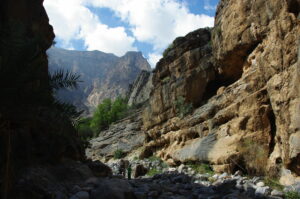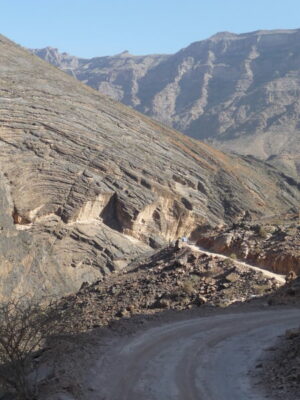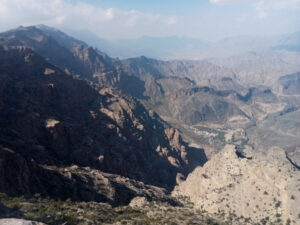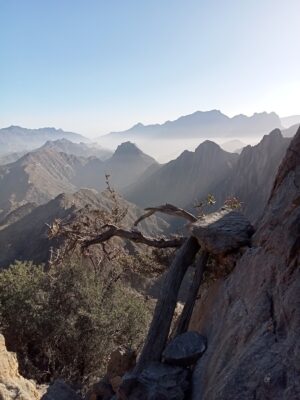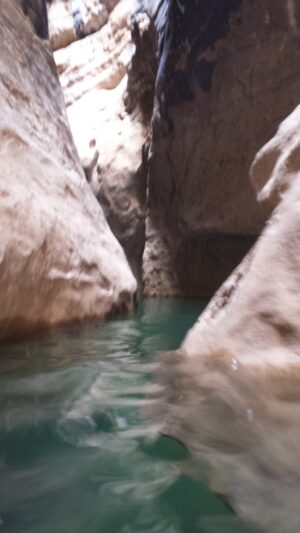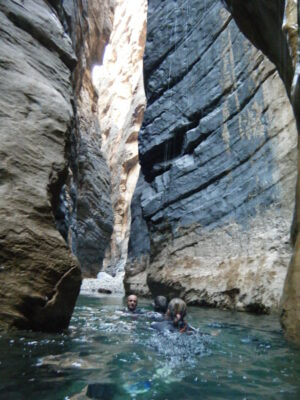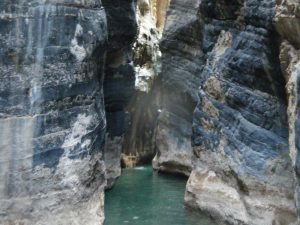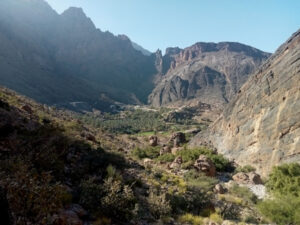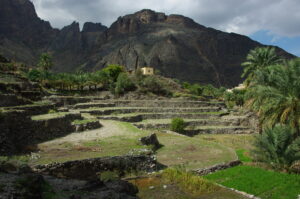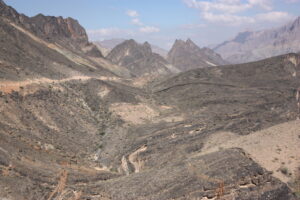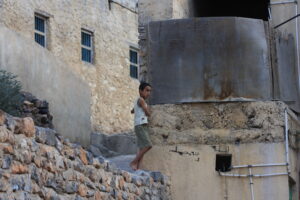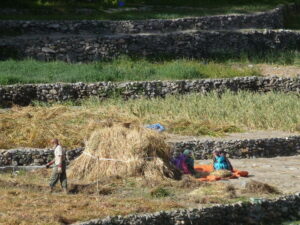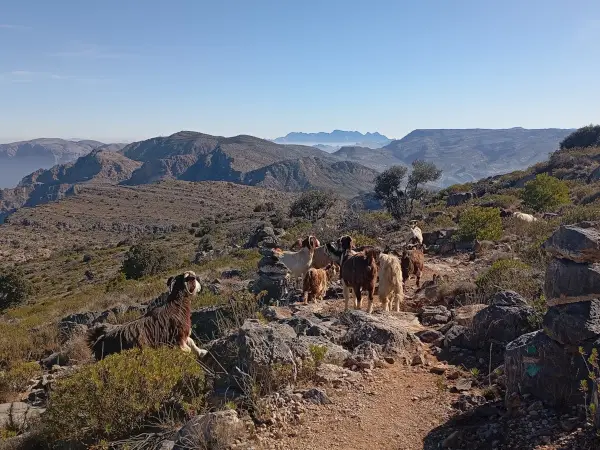Wadi Bani Awf
Geographical Situation
Wadi Bani Awf is one of the 4 main valleys on the northern slope of the Western Hajar : from east en west, there is Wadi Mistal, Wadi Bani Kharus, Wadi Bani Awf, and Wadi Sahtan.
The waters of Wadi Bani Kharus and Wadi Mistal meet in Wadi Al Abyadh.
Wadi Bani Awf flows towards Ar Rustaq where it meets Wadi Sahtan.
Above Wadi Bani Awf, the pass of Sharaf Al Alamain is the only way to cross the mountain chain by car (4WD mandatory), granting access to the southern slop and the cities of Al Hamra, Bahla, and Nizwa.
Quite central, the valley has also side tracks to reach Wadi Sahtan on the west and Wadi Al Hijir / Wadi Bani Kharus, on the east.
It’s also the valley shich has the most eneven terrain.



Yellowm lines : tarmac road and off-road tracks
Blue Lines : Snake Canyon
Green Lines : Hiking trails (marked and unmarked)
Access by car
The entrance of Wadi Bani Awf is just after Al Awabi. the first few kilometers are asphaltesd.
From Tikhah, starts off-road driving.
All along the valley, we are impressed by the broken harsh terrain and the many oases we cross.
Successively, secondary tracks lead to Wadi Sahtan on the right, and to Wadi Al Hijir (and from there to Wadi Bani Kharus) on the left.
In Zamah, you are in front of the exit of the Snake Canyon, a very narrow and deep canyon cut in black limestone (called by the geologists “fetid limestone”).
The track then ascents steeply on the right to round the canyon. It goes down in the lower branch of the canyon at Bimah. Befor reaching the bottom of the valley, a second track leads to Wadi Sahtan and a few other villages of Wadi Bani Awf. In Bimah, the track goes up again to skirt the second branch of the canyon.
We find quickly a side track on the right which leads to Balad Sit, emblematic village of the valley. The main track goes down passing along the soccer pitch and reaches the bottom of the valley at the entrance of the upper Snake Canyon.
A bit further, we notice another small canyon which grants access by foot to Balad Sit. For climbers, this small gorge is a very good spot : many routes have been equiped. Then, the track starts a long ascent to Sharaf Al Alamain pass going through Al Hajir and Hat.
All along the way, view points are splendid.
4WD is mandatory (in both ways) to drive through this wadi, as well as some experience of off-road driving in steep mountains.
Snake Canyon
It’s a beautiful very narrow canyon, cut in suprising black limestone.
The upper branch is the more technical one : 3 times abseiling at the begining of the descent, first 5m then twice 20m. Then it’s a following of bouledering, scrambling, jumping, and swiming.
The lower branch (from Bimah) is easier : there is no abseiling ; just a few places to climb down, a few jumps, slides, and of course swimming and bouldering…
Both branches meet half-way : we then continue the descent scrambling and swiming and reach a beautiful cave which we cross swimming (sometimes walking if the last floods brought stones in the pool…). Finaly the valley widens and we finish on dry terrain walking and scrambling.
It’s a classic in Oman. Not very difficult, fun, and impressing. Obviously, helmets are the minimum required safety equipment. For the upper part, you’ll need also harnesses, eights, carabiner, and at least a rope (or even 2) of 40m. To avoid scrathes, a wetsuit is recommended, but, to be honnest, we wear it accoding to the season : in Winter, we do, since water is cold! in Summer, we don’t, because it’s extremely hot when we are not in the water…
Unless you are experimented canyon enthusiast, it;s better to take a guide. You’ll find one easily in Balad Sit or Bimah in the guesthouses. We can also organize it for you with Deep or another local guide from the valley : Snake Canyon Inferieur et Snake Canyon Superieur.
Villages of Wadi Bani Awf
All along the valley, you’ll find villages of different size, with their palm gardens and terraced fileds.
The most famous is Balad Sit : set appart from the main valley, with access through a narrow gorge, we discover suddenly a village build on a small rock, surrounded by palm gardens and terraced open fields, and at the foot of impressive cliffs of more than 1000m.
Hiking and trekking
Many hiking trails link the villages of the high valley (Bimah, Selmah, Balad Sit, Hat), and give access to the main ridge. Some are marked, and others not…
From the main ridge, we can reach the village of Misfat Al Abreyeen, on the southern slope, Wadi Sahtan or Jebel Shams towards the west, and Wadi Bani Kharus and Jebel Akhdar towards the east.
All itineraries are splendid.
If you hike by yourself, there are plenty of information on the website Wilderness Trekking Oman. Keep in mind that many itineraries are very wild and little travelled, and that some paths might be in poor state and exposed…
We offer several treks from or to this central valley of the Western Hajar :
1 – From Wadi Sahtan to Wadi Bani Awf
6 days
Level 4
Trekking – from Wadi Sahtan to Wadi Bani Awf
Available in JanFebMarsNovDec
1 x Camping
1 x Bivouac
2 x Homestay
1 x Accomodation
2 – From Wadi Bani Awf to Misfat Al Abreyeen
5 days
Level 4
Trekking – From Wadi Bani Awf to Misfat Al Abreyeen
Available in JanFebNovDec
4 x Accomodation
3 – Crossing Jebel Akhdar
9 days
Level 4
Trekking – Crossing Jebel Akhdar
Available in JanFebNovDec
3 x Camping
5 x Accomodation
Because of the beauty of the valley, it’s central location in the range, and its dirt-track which give access to the souther slope, it is an area which we visit often in our Hiking Tours and Discovery Tours
Do you prefer to join a small group?
We offer Discovery tours, and Hiking Tours from October to April and Mountain Treks from November to March, on itineraries of different levels and adappted to the season.
You’ll find at the bottom of the page all ou next tours visiting Wadi Bani Awf.







